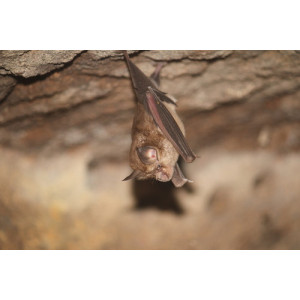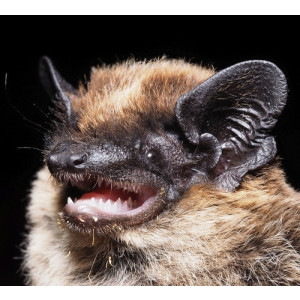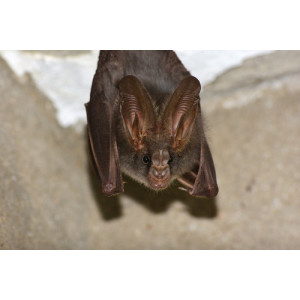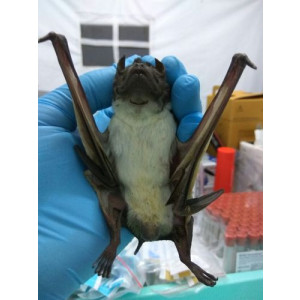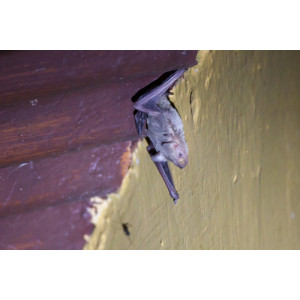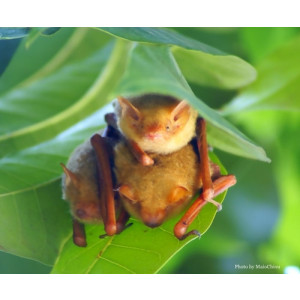Papillose Woolly Bat Did you see this animal?
Scientific Name : Kerivoula papillosa
Family : Vespertilionidae
Order : Chiroptera
Class : Mammalia
Phylum : Chordata
Habitat : Forest
Description : The Papillose Woolly Bat is a small bat, with a head and body length of around 4-5 cm (1.6-2 in) and a wingspan of about 16-20 cm (6.3-7.9 in). It weighs only 3-5 grams (0.1-0.2 oz).
The Papillose Woolly Bat has a woolly fur that helps it to stay warm in cooler environments. It has distinctive papillae (small bumps) on its upper lip and tongue, which are thought to aid in feeding. Its fur is typically brown or greyish-brown in color.
The Papillose Woolly Bat is found in tropical and subtropical forests. It roosts in tree hollows, crevices, and other sheltered locations.
The Papillose Woolly Bat is a nocturnal species that emerges at dusk to forage for insects. It is thought to be primarily insectivorous, feeding on small flying insects such as moths and mosquitoes. It has been observed feeding on nectar and pollen as well.
he Papillose Woolly Bat uses echolocation to navigate and find prey. It emits high-frequency calls that bounce off of objects in its environment, allowing it to create a mental map of its surroundings.
This bat feeds primarily on insects, particularly moths and other small flying insects. It uses its sharp teeth and powerful jaws to capture and consume its prey.
Little is known about the reproductive biology of this species, but it is thought to give birth to a single offspring per year.
The Papillose Woolly Bat is currently classified as a species of least concern by the International Union for Conservation of Nature (IUCN), as it has a wide distribution and is not currently facing major threats. However, habitat loss and degradation could pose a risk to its populations in the future.
The Papillose Woolly Bat has a woolly fur that helps it to stay warm in cooler environments. It has distinctive papillae (small bumps) on its upper lip and tongue, which are thought to aid in feeding. Its fur is typically brown or greyish-brown in color.
The Papillose Woolly Bat is found in tropical and subtropical forests. It roosts in tree hollows, crevices, and other sheltered locations.
The Papillose Woolly Bat is a nocturnal species that emerges at dusk to forage for insects. It is thought to be primarily insectivorous, feeding on small flying insects such as moths and mosquitoes. It has been observed feeding on nectar and pollen as well.
he Papillose Woolly Bat uses echolocation to navigate and find prey. It emits high-frequency calls that bounce off of objects in its environment, allowing it to create a mental map of its surroundings.
This bat feeds primarily on insects, particularly moths and other small flying insects. It uses its sharp teeth and powerful jaws to capture and consume its prey.
Little is known about the reproductive biology of this species, but it is thought to give birth to a single offspring per year.
The Papillose Woolly Bat is currently classified as a species of least concern by the International Union for Conservation of Nature (IUCN), as it has a wide distribution and is not currently facing major threats. However, habitat loss and degradation could pose a risk to its populations in the future.
Distribution in Bangladesh
References:
description written by:Asad U. Tanvir,Department of Zoology,Jagannath University,Dhaka; reviewed by:Muntasir Akash,Department of Zoology,University of Dhaka;Taxonomic Checklist:Red List of Bangladesh Volume 2: Mammals, 2015, IUCN; information sources:Wikipedia , iucnredlist.org; photo credit:Biodiversity Heritage Library(www.inaturalist.org/people/), photo copyright: iNaturalist.more information please contact with us.
description written by:Asad U. Tanvir,Department of Zoology,Jagannath University,Dhaka; reviewed by:Muntasir Akash,Department of Zoology,University of Dhaka;Taxonomic Checklist:Red List of Bangladesh Volume 2: Mammals, 2015, IUCN; information sources:Wikipedia , iucnredlist.org; photo credit:Biodiversity Heritage Library(www.inaturalist.org/people/), photo copyright: iNaturalist.more information please contact with us.



